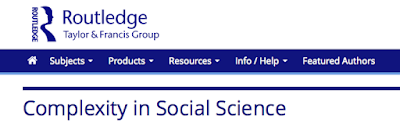The purpose of this blog entry is to introduce readers to our new approach to measuring diversity in communities and systems, called case-based complexity.
OUR TEAM
Rajeev Rajaram and Brian Castellani (and Anna Wilson for studying energy distributions)
Why Diversity?
Diversity in systems is a major topic of concern across the sciences. From Shannon Entropy in communication systems to the GINI Index to True Diversity measures in evolutionary biology and ecology, the issue of diversity is a major concern. Here, for example, are some key topics concerned with diversity:
- Economic Inequality
- Cultural diversity in society
- Species diversity in an ecological community
- Diversity of information in cybernetic systems
- Diversity of major and minor trends in longitudinal data
- Diversity of health and well-being
- Trade or political diversity of a country
- Network diversity
- Diversity of complexity in systems
- Power laws
- Pareto distributions
- Scale-free networks
- Energy distributions at the atomic and subatomic level
- Genetic and biological diversity
Measuring Diversity
For us, case-based entropy is a measure of the diversity within a complex system (be it physical, biological, psychological, social, ecological, etc) that incorporates both species richness (the number of cases in a system) and the evenness of species' abundances (the diversity of types, be they discrete or continuous).
Case-based entropy is based on the work of Lou Jost and Claude Shannon -- see links to Jost below! However, while it deals with probability distributions, it is not simply another measure of probability in systems. Instead, it has to do with diversity in systems. To make sense of our approach, we have provided the following below, including three introductory videos as well as links to our recent publications on the topic.
BEFORE WATCHING OUR VIDEO, WE RECOMMEND WATCHING THE FOLLOWING QUICK VIDEO ON SHANNON ENTROPY BY KHAN ACADEMY -- WHICH IS WONDERFUL!
VIDEOS, PREZI, PUBLICATIONS AND INTRODUCTORY ARTICLES
The goal of the below three videos, Prezi and additional materials it to introduce readers to case-based entropy, a new approach to measuring diversity in communities and systems.
CASE-BASED ENTROPY: AN INTRODUCTION
THE MATHEMATICS OF CASE-BASED ENTROPY
EXAMPLES OF CASE-BASED ENTROPY: FROM GALAXIES TO GASES
2. CLICK HERE to read or download our publications related to case-based entropy and case-based complexity.
3. CLICK HERE to read our Physica A Paper on the Mathematics of Case-Based Entropy
4. CLICK HERE to read our paper in Complexity on Case-Based Complexity and the 60/40 Rule
2016 Castellani, B., and R. Rajaram. “Past
the Power Law: Complex Systems and the Limiting Law of Restricted Diversity.” Complexity.
5. THE WORK OF LOU JOST
Our impetus for focusing on true diversity comes from evolutionary biology and ecology, where it is employed to measure the true diversity of species (types) in a given ecological system of study.
Specifically, it comes from the brilliant work of Lou Jost -- see his website.
- 1. What does it mean to talk about diversity in systems?
- (CHAPTER BY LOU JOST)
- 2. So, what is TRUE DIVERSITY and HOW SHOULD IT BE MEASURED?
- (ARTICLE BY LOU JOST)
- 3. Entropy and Divesity
- (ARTICLE BY LOU JOST)









